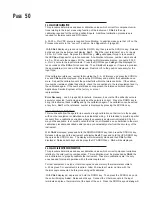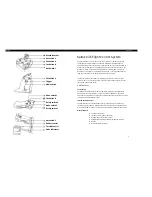
P
AGE
58
mADC Output(s)
1. Verify that the Program and Tune mode
Malfunction
parameters are correctly set (page 29 & 35 or the
Software Ref. Sheet, page 77, if already filled out).
2. Turn off the power to the instrument . Wait about 5
seconds and turn the power on again. Confirm
that the model number displayed during the power
up sequence indicates that the output is present in
the instrument. The number should match the
model number on the label located on the lower
front of the display bezel. If model # is incorrect,
follow steps for "Model # displayed is incorrect"
(page 56).
3. Turn off the power to the instrument. Loosen the
front panel screw and remove the unit from the
housing. Inspect the Option board (Appendix A-3,
page 66 and 67) for the presence of the Current
Output Driver IC. Current 1 output is U-1 and
Current 2 output is U-5. The current output cannot
function without the hardware being present .
Return the instrument to the housing and tighten
the front panel screw.
4. Refer to the Test section (page 52) and carry out
the procedure for the output(s) that is/are not
working. Test 7 operates current Output 1 and
Test 8 for current Output 2. If the current output
operates properly in the Test mode re-check the
Program and Tune mode parameters (page 29 &
35 or the Software Ref. Sheet, page 77, if already
filled out).
Error Code Displayed - The display of error codes except Er 40 - 60 will cause on/off
outputs to turn off and proportional outputs to be the value selected in the
Program Mode parameters P1EC and/or P2EC
SnSr
1. Inspect the sensor for proper operation and
Sensor Break or out of range
connection to the instrument. Acceptable sensor
ranges for the instrument are listed in the
Specifications section of Appendix D (page 73).
2. Verify that the Program Mode input selection
matches the sensor input connected.
3. Check that the input conditioning jumpers on the
Processor board (Appendix A-2, page 65) and the
Option Board (Appendix A -3, page 66 and 67)
are in the proper position for the sensor input.
4. Perform the calibration procedure(s), as described
in the Calibration section (page 48) , for the sensor
input type.
rSEr
1. Check that the Remote Setpoint signal is present
Remote Setpoint Error
and of the polarity between terminals 8 (+) and
5 (-).
2. Perform the Auxiliary Input Test, Test 9 as
described in the Test section (page 55), the
voltage indicated during the test should be the
same as measured in the preceeding step.
3. Verify that the Remote Setpoint input voltage range
selected in the Program Mode (page 29) is the
same as the voltage that is present at the Remote
Setpoint input terminals.
















































